Dualism, apart from its numerous variants, whose analysis would exceed the purpose of this book, is a philosophy according to which everything in the universe is composed of two principles in sharp contrast. These essences, one celestial and one terrestrial, together create Unity, manifesting in this way their reciprocal interdependence. Although Pythagoras spoke of them in the VI century BC, and although this doctrine was the requisite condition for multiple forms of Gnosticism, of which it is one of the fundamental theoretical pillars, it is something even more remote. Palaeolithic art, for example, reflected it in forms of surprising complexity, through figures of animals with masculine or feminine characteristics or with the contemporaneous, superimposed association of several species, as horse and bison, in which one subject was the expression of the masculine and one of the feminine. Such a remote genesis is ascribable to the fact that Dualism is not a simple philosophical or religious concept but belongs to our world; it is inborn to it because it describes and represents it. Concerning this, it is enough to reflect upon certain dualistic manifestations that accompany us in our daily lives, such as day and night, man and woman, hot and cold, life and death, and so on. But what is its importance within our own context? What does it offer us? Let us begin with an hypothesis:
dualism
is at the basis of the teaching of the Tarot
.
The Swiss psychiatrist Karl Gustav Jung, one of the founding fathers of modern psychology, taught that in every person there are opposite essences, the “inferior” ego and the “superior” Self. It is not necessary to examine the countless nuances of this concept but it is in any case indispensable that we comprehend that, according to this hypothesis, man is composed of two principles: Personality and Soul .
The first, the ego, is terrestrial, weak, timid and fearful and leads us towards a life based on fear and suffering... The Soul, the superior and heavenly Self, on the contrary, is the altruistic element characterized by the quality of self-awareness, founded upon joy and hope. Our ordinary consciousness moves inside the personality but knowing better the particular traits of both, we may discover when it is, that the Soul has more influence, as one who walks along a path of interior evolution.
The dualistic vision is not the exclusive prerogative of certain psychological currents of thought, but concerns, although in different forms and modalities of presentation, even the diverse interpretations of the authentic initiatic Traditions. Very briefly, these teach that human beings should tend to realize an improvement in their capacities of control of emotions, sensations and thoughts, in order to render the personality (which is governed by these principles) more docile and open to a meeting with the Soul. For example, control of the mind, our principal tool of investigation, usually distinguished by logical and rational thought, allows us entry to the world of Intuition, which is the most direct means of communication with the Soul, and is the modality by which human beings may receive thoughts of a superior level. Although this last faculty cannot be classified as a regular and predictable manifestation, it is scientifically recognized as a true and efficacious capacity. In fact, as women know better than men do, it is a precise form of awareness that may be learned and trained through a gradual work of improvement and perfection of oneself. Therefore, the Jungian hypothesis is a modern adaptation of the thousand-year-old teachings of Sacred Scriptures, Western and Eastern. Thus, the possible discovery of a dualistic framework in the Coded Structure , would be revealed as not only essential for understanding the Tarot, but also perfectly coherent with the ancient traditional wisdom. Having stated beforehand that in the Arcana Dualism is ubiquitous, let us endeavour to understand how it is expressed in the design of the cards, beginning with some particular examples.
In the Tarot Dualism, however expressed by heterogeneous modalities, is codified through the contrast between two elements present on the same card or on two different cards Therefore, in whatever opposition (Male/Female, Dressed/Nude, Gaze tuned to right/Gaze turned to left and so on, on a long list), there is always a subterranean dualistic sense. Various images follow for comparison.
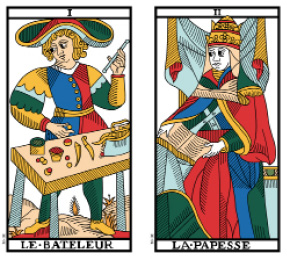
Fig. 13
Standing - Seated
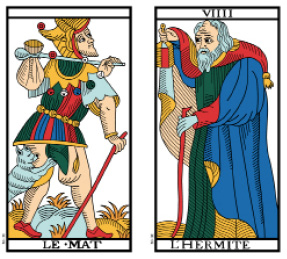
Fig. 14
In movement - Still
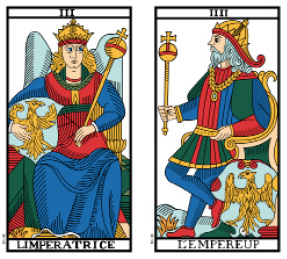
Fig. 15
Male - Female
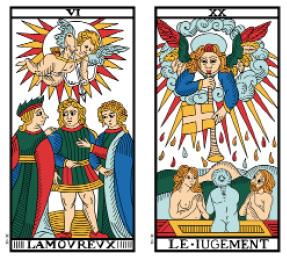
Fig. 16
Human - Angel
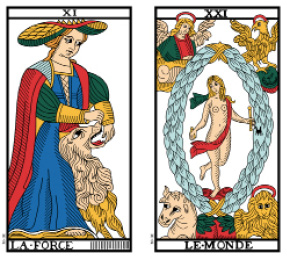
Fig. 17
Dressed - Nude
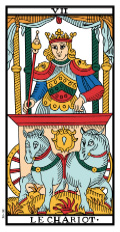
Fig. 18
Man - Animal
All these criteria, independently from their specific differences, clearly bearers of more and distinctive meanings, always suggest the same idea of Antithesis . This because ultimately, the principal objective of this teaching is to emphasize the rapport of contraposition and mutual relationship between the Earth (the terrestrial and material) and the Heavens (the celestial and spiritual). In man, this antithesis is expressed by the two parts, inferior and superior, incarnated by the two principles called personality and Soul. Therefore, the relevant form of Dualism elaborated in the Tarot, to which every other duality leads back, is Matter-Spirit.
As example, let us analyze what individuation in the cards of Male-Female antagonism, entails.
In the 3x7 Diagram, just at the beginning, a relevant fact regarding the principle of the entire deck, there is a couple twice over, as suggested by the name itself of the cards, namely, the Empress and the Emperor on one side and the Hierophant and the High Priestess on the other:
Emperor-Empress
and High Priestess-Hierophant
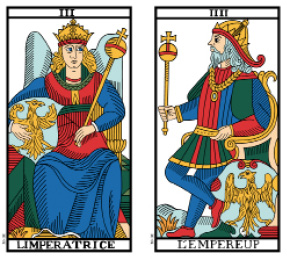
Fig. 19
Empress-Emperor
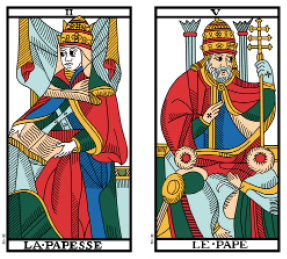
Fig. 20
High Priestess - Hierophant
In the couple, we find not only Male-Female Dualism but also Terrestrial-Celestial Dualism as, symbolically, the feminine leads to the concept of Mother-Earth and the male, to that of the Heavenly Father. The dualistic concept, however, is expressed also in other forms.
The first couple governs the temporal and material world; while the second rules over the spiritual and divine. We are still facing a terrestrial-celestial Dualism, which confirms our supposition:
Empress + Emperor → Terrestrial World
High
Priestess + Hierophant
→
Celestial
World.
If we look more closely, we discover another interesting detail: the sceptres of the Emperor and the Empress symbolize the Earth 44 symbolically represented by a circle and a cross, while in the Hierophant (on his pastoral staff) and the High Priestess (on her breast); instead, there are Three Crosses. These symbolize the Heavens, by the circle of the Zodiac which, having 12 astrological signs disposed in a circle, may be divided precisely by three crosses. 45

Fig. 21
The two Sceptres
Fig. 22
The 3 Crosses
Fig. 23
The Zodiac and the 3 Crosses
Comprehending Dualism, means causing fragments of an exact teaching to appear. Specifically, the individuation of a terrestrial couple might suggest that its members are more connected to the personality; the presence of the celestial couple, on the contrary, might indicate a connection with the idea of the Soul. In order to further confirm this reasoning, let us observe the order of the four figures along the first row of the 3x7 Diagram.

Fig. 24
Lower row- Terrestrial of the 3x7 Diagram
We note that in the terrestrial couple, the two subjects are in sequence and look at one another. We may deduce that, in order to stay together, they must interest themselves each in the other, forming a couple that, close-knit, is perhaps somewhat internalized in itself. This is their natural condition, because the disposition of the cards is in an ascending and progressive order (III and IV). In the case of the Hierophant-High Priestess, on the other hand, the two figures have their backs turned naturally to each other, they take no interest one in the other. Not because they do not love each other, but because their being together is an existing condition even while they care for others or for other things, outside their union.
These evaluations are indubitable as in both cases, thanks to the names on the scrolls, we may be sure that we find ourselvces before a “perfect” couple, constituted of personages with a great mutual affinity. Therefore, thanks to these simple verifications we may deduce that one couple is more “egotistic”, one more “altruistic”. Thus, because these, as we have already said, are two fundamental parameters necessary in order to discover if human beings are dominated by the personality or by the Soul, we may again confirm that the first two personages are more terrestrial and the other two, more celestial. All this goes to demonstrate how incessant and continuous is the proof, every particular a bearer of coherent and meaningful clues. Let us continue to observe.
In the couple of the Empress and the Emperor we see an eagle. This is a symbool of the animal principle of the human being, which might indicate a stronger tie with the primordial instincts. In the case of the Hierophant and the High Priestess, on the contrary, there is no animal, which in this case also, might be proof of their higher evolution. In order to identify other details, with the objective of revealing new enigmas (Codes), it would be well to remember an aspect of maximum relevance. Every time that, seeking to uncover the dualistic sense present in the illustrations, we make a comparison between two similar elements, be they two symbols, two concepts, or other, we must consider that, between them there always exists a difference. There is never and there may never be, by the way in which the Tarot codify, complete equality. This criterium, which is called the Law of Difference , is applicable not only in this specific context but has general repercuassions of great importance.
This rule dictates the necessity to pinpoint which differences (graphical, symbolical, and of sense) exist between two similar elements. Thus, observing the cards again, let us focalise our attention on the last detail analyzed. The two eagles, however similar, are characterized by innumerable diversities which, as for all the other symbols, past researchers have always neglected: there being many Tarot decks, one so graphically different from another, attention was paid to the esoteric sense, to the detriment of the particulars of the illustration themselves! In the object in case, observation leads to the discovery of remarkable differences. First, one eagle looks to the right and one to the left. One is female (because she has an egg); one, having none, is male. One, on the left part of the card, points its wings toward the sky and is in the air, touched by a hand. The other, on the right, has its wings pointed downwards, is on the ground, and is touched by a foot:
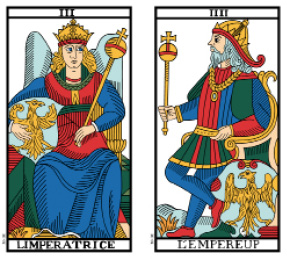
Fig. 25
The two Eagles
Head toward the right - Head toward the left
With egg - Without egg
Wings toward the sky - Wings toward the ground
On the ground - In the air
Right side of the card - Left side of the card
Hand - Foot.
Each of these disparities, as all of which might appear from even deeper analysis, bears a precise meaning. For example, the different orientation of the wings, as does the position relative to the ground, suggest a terrestrial-celestial opposition. In addition, the head turned to the left indicates the past; to the right, the future 46 (again an antithesis). In any case, what we wish to emphasize here is, as one of the two birds of prey is female; while the other is male, we find the idea of a couple of eagles, precisely as is the case with the two royal protagonists who moreover, are connected with the animal principle of an opposite sex complementary to each other’s.
Male
Eagle-Empress and Female Eagle-Emperor
Thus, for the III-IIII couple we have confirmation of the connection with the personality, here represented by the terrestrial instincts described by the animal part, the eagle. On another level of interpretation, to have determined the presence of a couple of eagles allows us to find the terrestrial-celestial Dualism in yet another form. Inside the couple, the eagle symbolizes the terrestrial part and the human being (more evolved than the animal, therefore of a superior degree), the celestial: again, the personality-Soul duality! All depends on the plan of analysis, although coherence with respect to global teaching is at the base of all evidence.
As the two eagles appear similar only at a first, superfical observation, thus in sacred art, of which the Tarot is the maximum expression, there exists an analogous mode known as the Principle of Imperfection , which predicts the presence of voluntary assymertry in the artworks. This Rule, not easy to decipher but always present, is not associated only with the Dualism of the Arcana but has explicit correlation with other esoterical sciences.
When the two symbols or the two concepts have something in common, there exists a difference which obeys the dualistic principle. It is enough to simply seek out any real contrast between the two cards or two elements analyzed. These differences not only render all of the teachings richer and more elaborate, but as we will explain, are also used in the practical reading of the Tarot.
Once we have assimilated what Dualism is and how it manifests, let us seek to understand in what manner this concept reflects on the general structure of the Tarot, with a brief exercise.
As an overview, consider the Minor Arcana (fig. 1). We should now emphasize that the four suits, apart from their symbolic value, are represented by objects. The figures, that is, the pages, queens, kings and knights, are human personages. In both cases, therefore, as we have already demonstrated, we are facing something that belongs to the world of earth, something terrestrial.
Minor
Arcana
→
objects
and men
→
terrestrial,
human world
Now let us observe again the Major Arcana on the 3x7 Diagram (fig 12). In this case we find ourselves before humans, but also figures mythological (the sphinx), celestial (angels, the devil), and heavenly bodies (the Moon, the Sun, the Star) etc, a universe in its entirety, magical, mysterious and spiritual.
Major
Arcana
→
magical
world
→
celestial
and spiritual world
Here we are again facing Dualism! The contrast is great; there has been a forceful attempt to oppose two levels, that of the earth and the personality, the Minor Arcana, to that of the heavens and the Soul, the Major Arcana. We may certainly affirm that Dualism is fundamental to the structure of the Tarot itself, constituted, as is a living being, by two basic principles:
The Minor Arcana : the earthly world → personality of the Tarot
The
Major Arcana: the heavenly world
→
Soul
of the Tarot.
Thanks to all this we may say that the progressive comprehension of the Arcana and of the inherent teaching codified in it, allow the discovery that, surprisingly, the Tarot has the function to help us establish a contact and an accord between our inferior part, the personality, and the superior, the Soul, an objective hoped for by every authentic form of Tradition.
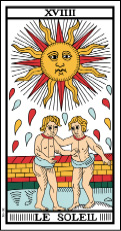
Fig. 26
The Sun
The Path of the Tarot, in technical terms, we might call a form of yoga. 47 This path, in fact, offers the possibility of a connection, a bridge, between these two innate principles in every human being, harmonizing them so that they collaborate for the same ends. If we observe the XVIIII Tarot card (fig 26), the concept may be somewhat clearer. We see two personages, one of whom awaits and welcomes the other, who, slightly disoriented, reaches him walking on the waters. This is the symbolism of the Soul (the figure on the right) who welcomes the personality (on the left), that is, of these two principles who find equilibrium between each other, becoming friends and brothers.
Actually, this concept is perfectly expressed in Astrology as well when, if treated seriously, is a Science which deals with the esoteric study of the individual and his relations with the cosmos. In fact, the sign of Gemini leads back exactly to the same notion. The principle stars of the constellation, represented by the young twin boys of Greek mythology Castor and Pollux, indicate the two dualistical elements. It is not, then, a coincidence that when one sets, the other rises, as witness to the idea that if the personality becomes more docile and tollerant, the Sun rises to its luminous task of guidance.
With the Tarot, it is possible that this particular condition manifests itself, although in a different manner, for those who decide to follow this initiatic Path in the first person, or for those whio turn to the Arcana with the intention of asking and receiving practical advice. In the first case, the work will consist in the construction, over time, under the impulse of interior knowledge gained by the study of these images, of a true contact with ones’ own superior Self. In the second case, it is a matter of helping the person who requests a consultation, to listen to the voice of the deepest part of himself, so as to allow a more knowledable orientation in every decision.
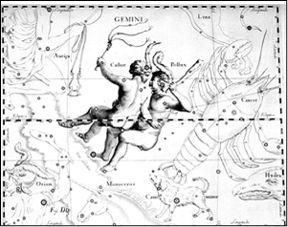
Fig. 27
The Sign of Gemini
During a consultation, in fact, the tarologist 48 , knowing the true essence of these cards, 49 in dialogue with the personality of the consultant, allows it to draw nearer to the Soul which, in presence of the Tarot, appears. In this case, the principle objective in consulting the Tarot consists in an agreement between the two parts, often in contrast between themselves, so as to offer concrete aid for individual evolution.
We know well how much suffering and pain a life far from those inclinations and talents each of us guards or hides inside oneself can bring. We need only think of the boredom and discomfort, if not suffering, of a job done “only to get to the end of the month”, after having given up the activity which one dreamed of since childhood. When the Soul has ambitions different from those of the personality, our projects, if purely material and terrestrial, find difficulties and obstacles, as a result of which we do not finish them as we intended to do, because the Soul always brings us back, even if gradually and over time, to our own path, that is, towards ourselves. One of the essential qualities for being able to welcome its true presence, is to learn to recognize the profound altruism which it constantly evokes, comparing it to that egotism and that thirst for pleasure so desired by our personality.
After long experience as a tarologist and teacher of Tarot, I may say with absolute certainty that almost all difficulties met by persons who turn to this instrument in order to receive support and knowledge, derive from a lack of harmony and understanding between the intentions of Soul and personality. When this last prevails, it becomes a tyranny over us, possessive and greedy, and leads us towards the realization of individualistic projects without generosity, that always leave us empty and unsatisfied. If it is the Soul to guide, however, as the human being gradually establishes a greater communione with it, it moves in the direction of an interior realization which reflects in all it does, every day. Terrestrial and spiritual intentions converge; this does not only make us happy, but also radiates a sense of well-being towards those to whom we give our attention, making possible the construction, right here on earth, of that kingdom of serenity which belongs not only to the heavens.
This brief exposition on Dualism, which does not claim to be thorough, is only an outline. Given the immense vastness of the material, and needing to deal with various subjects, we may not linger more. Our intent was, however, a double one: on the one hand, to represent several ways in which the Tarot codifies Dualism, through description of particular cases, or through evidence that the general structure itself is based precisely upon this concept; on the other, through practical exercises, to allow the reader to gain confidence with the fact that the Tarot bases the revelation of its teaching on the capacity of observation , without the development and training of which, it is not possible to understand its sense.